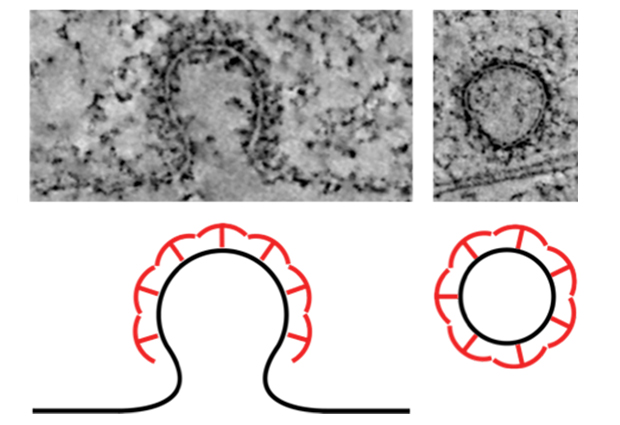Decades-old cell biology puzzle solved
Researchers at EMBL Heidelberg have solved a question that has puzzled cell biologists for decades – how does the protein machine that allows cells to swallow up molecules during endocytosis function?

Endocytosis is the process by which cells engulf molecules and draw them inside the cell where they perform different functions. This engulfment involves making dimples in the cell membrane that deepen with time and eventually seal off to make a spherical vesicle inside the cell. Essential to the process is the formation of a lattice-like protein shell on the surface of the vesicle membrane. However, there is still no consensus as to the exact function of this coat. Even for the best understood coat protein, clathrin, opinion has split between two different models.
In the first model, the clathrin lattice, or coat, first assembles as a flat structure, and then bends, essentially wrapping around the forming vesicle. In the second model, scientists suggest that clathrin assembles directly, assuming the shape of the membrane as it is drawn inwards.
Although the second model has been more generally accepted, a new paper published in Science shows that, in fact, the first explanation is more accurate. In their experiments, the team at EMBL Heidelberg used human cell lines in which the sites where endocytosis was taking place had been tagged with a fluorescent marker.
EMBL postdoctoral researcher, Ori Avinoam, then used 3D electron microscopy to take pictures of these sites and analysed them to understand how they changed shape over time.

By analysing the images computationally, the research team was able to demonstrate that the surface area of the clathrin coat does not change during endocytosis, only its curvature changes as it draws the cell membrane inwards.
Our results were surprising, because the proteins have to undergo some complicated geometric transformations to go from a flat to a curved shape
John Briggs, group leader at EMBL Heidelberg, said: “Our results were surprising, because the proteins have to undergo some complicated geometric transformations to go from a flat to a curved shape, which is why the second model was favoured by scientists for such a long time,”
“The next stage of our research is to investigate more precisely how this rearrangement occurs,” adds Marko Kaksonen, also a group leader at EMBL Heidelberg. “We also want to look at other aspects of the process, such as how the molecules ingested by the cells might themselves influence the action of the clathrin proteins. Answering these fundamental questions of cell biology will help scientists better understand the whole process of endocytosis.”



